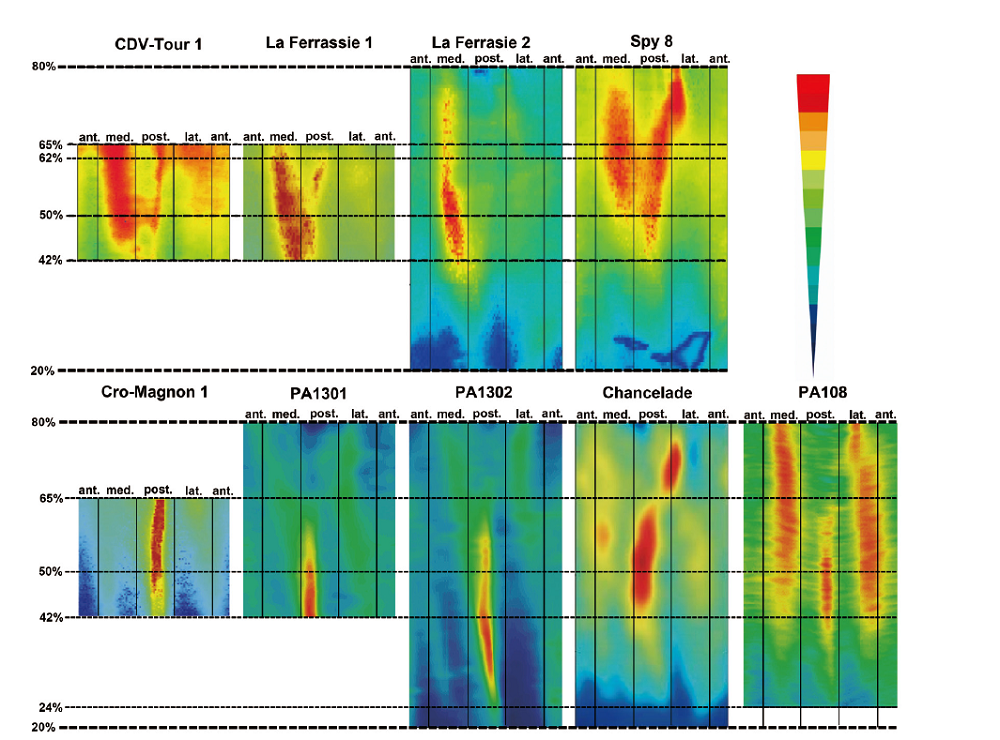| 35% | Q1 | KNM-ER 736, 737, 803a, 1472, 1481a, 1808mn, Kresna 11 |
| Q21 | A?n Maarouf 1, AT-SH F-IX, X, Gesher-B.-Y. 1, OH 28, Trinil II, III, IV, V |
| Q23 | Broken Hill E690 |
| Nea. | Amud, Chapelle-aux-Saints 1, Feldhofer 1, Ferrassie 1, 2, Fond-de-Forêt 1, Spy 2, Tabun 1 |
| Q2 | Qafzeh 9, Skhul 4, 5, 6, 7, Cro-Magnon 1, 4322, 4328, Dolní V?stonice 3, Dolní V?stonice 13, Dolní V?stonice 14, Dolní V?stonice 16, Dolní V?stonice 40, Ein Gev 1, Minatogawa 1, Minatogawa 3, Minatogawa 4, Mlade? 27, Nahal ‘En-Gev 1, Ohalo 2, Paviland 1, Pavlov 1, Sunghir 1, 4, Trinil Ⅰ |
| 50% | Q1 | KNM-ER 736, 737, 803a, 1472, 1481a, 1808mn, BOU_VP_2/15,19/63, Kresna 11 |
| Q21 | A?n Maarouf 1, AT-SH F-IX, X, XIII, XIV, XVI, Gesher-B.-Y. 1, OH28, Trinil II, IV, V, Zhoukoudian 1, 2, 4, 5, 6, |
| Q23 | Berg Aukas 1, Broken Hill E690, E793, Castel del Guido 1, Ehringsdorf 5, La Chaise-BD 5, Mammolo 1, Tabun E1, Lazeret 15/17, 25, Karain |
| Nea. | Amud 1, CDV-Tour 1, Chapelle-aux-Saints 1, Feldhofer 1, Ferrassie 1, 2, Fond-de-Forêt 1, Palomas 96, Quina 5, Rochers-de-V. 1, Saint-Césaire 1, Shanidar 4, 5, 6, Spy 2, Tabun 1, 3 |
| 50% | Q3 | Qafzeh 3, 8, 9, Skhul 3, 4, 5, 6, 7, Arena Candide 1, Barma Grande 2, Cro-Magnon 1, 4322, 4324, Dolní V?stonice 3, 13, 14, 16, 35, Ein Gev 1, Grotte-des-Enfants 4, Minatogawa 1, 2, 3, 4, Mlade? 27, Nahal ‘En-Gev 1, Ohalo 2, Paglicci 25, Paviland 1, Pavlov 1, Rochette 2, Sunghir 1, 4, Veneri 1, 2, Willendorf 1, Zhoukoudian-UC 67, UC 68 |
| 65% | Q1 | KNM-ER 736, 737, 803a, 1472, 1481a, 1808mn, Kresna 11 |
| Q21 | A?n Maarouf 1, AT-SH F-X, XI, XIII, XVI, AT-1020, Gesher-B.-Y. 1, OH 28, Trinil II, III, IV |
| Q23 | Broken Hill E690, Tabun E1, Karain |
| Nea. | Amud 1, CDV-Tour 1, Feldhofer 1, Ferrassie 1, 2, Fond-de-Forêt 1, Krapina 257.32, 257.33, Palomas 52, 92, 96, Quina 38, Shanidar 6, Spy 2 |
| Q3 | Qafzeh 6, 8, 9, Skhul 4, 5, Cro-Magnon 1, 4322, 4324, Dolní V?stonice 3, 13, 14, 16, 41, Eiv Gev 1, Minatogawa 1, 3, 4, Mlade? 27, 28, Nahal ‘En-Gev 1, Ohalo 2, Paviland, Pavlov 1, Sunghir 1, 4, Tianyuan 1, Willendorf 1 |
| 80% | Q1 | KNM-ER 736, 737, 803a, 1472, 1481a, 1808mn, Kresna 11 |
| Q21 | AT-SH F-X, XI, XIII, XIV, XVI, AT-1020, Gesher-B.-Y. 1, OH 28, Trinil II, III, IV |
| Q23 | Broken Hill E689, E690, E709, La Chaise-BD 5, Tabun E1 |
| Nea. | Amud 1, Chapelle-aux-Saints 1, Feldhofer 1, Ferrassie 1, 2, Krapina 213, 214, Saint-Césaire 1, Spy 2, Tabun 1 |
| Q3 | Qafzeh 8, 9, Skhul 4, 5, 6, 9, Arene Candide 1, Barma Grande 2, Cro-Magnon 1, 4322, Dolní V?stonice 3, 13, 14, 16, 35, Ein Gev 1, Grotte-des-Enfants 4, Minatogawa 1, 2, 3, 4, Mlade? 27, 28, Nahal ‘En-Gev 1, Ohalo 2, Paglicci 25, Paviland 1, Pavlov 1, Rochette 2, Sunghir 1,Tianyuan 1, Veneri 1, 2 |











